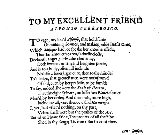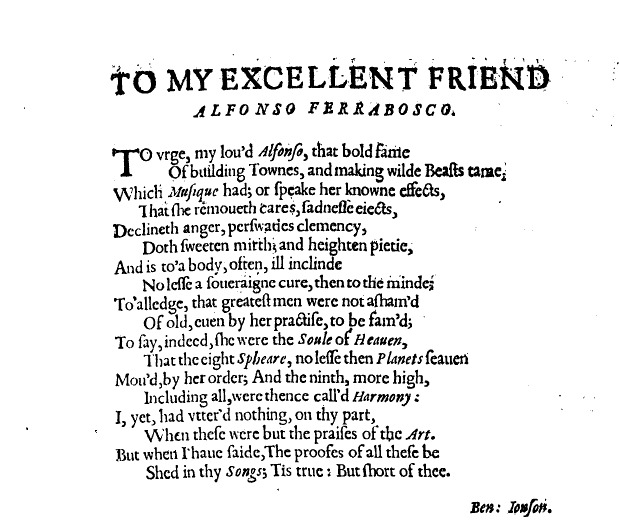
Alfonso Ferrabosco the younger
Encyclopedia
Alfonso Ferrabosco the younger (c. 1575 – March 1628) was an English
composer
and viol
player of Italian
descent. He straddles the line between the Renaissance
and Baroque
eras.
, the illegitimate son of the Italian composer Alfonso Ferrabosco the elder
. His mother might have been Susanna Symons, whom Alfonso the elder later married. Ferrabosco the younger was left under the guardianship of Gomer van Awsterwyke, a member of the queen's court
. Although Alfonso the elder asked for Alfonso the younger to be sent to him in Italy, where he had moved with his wife, the queen insisted that he stay in England. Ferrabosco remained in Gomer van Awsterwyke's care until his death in 1592. At this time he started a long career as a court musician, including as the private music tutor of Prince Henry
.
 Ferrabosco collaborated with Ben Jonson
Ferrabosco collaborated with Ben Jonson
on several projects, including The Masque of Blackness
(1605), and wrote music for several other masque
s besides. His music was published by John Browne in 1609, including a number of settings of poems by John Donne
and Thomas Campion
, as well as lute
and viol music. He frequently wrote in the new declamatory Baroque style, and although he never went to Italy, he was well aware of contemporary Italian music.
Ferrabosco the younger's reputation was built largely on his prowess as a viol player, and even more so his compositions for viol consort
. These were highly idiomatic works, with lots of divisions, and virtuosic lines. He also wrote many In Nomine
s, which were great examples of that popular genre, without the pedantic bent many later In nomines were given to. Ferrabosco was also one of the first to write lyra viol
music in tablature, along with Coprario
, and wrote a book of Lessons for the lyra viol.
Ferrabosco continually had difficulty with debts, and was involved in an unsuccessful scheme involving various rights on the River Thames
, including dredging it for gravel, and imposing fines on people who caused a nuisance on it. He died in March 1628 and was buried at St Alfege Church on 11th of that month, in his home village of Greenwich.
(c.1523–1612) and his second wife Lucretia). they had three notable sons: Alfonso Ferrabosco (d. 1652), Henry Ferrabosco
(d. 1658?), John Ferrabosco
(bap. 1626, d. 1682) all of whom were musicians. Two of his daughters are know to have married musicians: Elizabeth married George Bunckley, and Catherine married Edward Coleman. Coleman was a court musician after the Restoration. The were friends of Samuel Pepys
and both of them are know to have sung in theatre productions.
England
England is a country that is part of the United Kingdom. It shares land borders with Scotland to the north and Wales to the west; the Irish Sea is to the north west, the Celtic Sea to the south west, with the North Sea to the east and the English Channel to the south separating it from continental...
composer
Composer
A composer is a person who creates music, either by musical notation or oral tradition, for interpretation and performance, or through direct manipulation of sonic material through electronic media...
and viol
Viol
The viol is any one of a family of bowed, fretted and stringed musical instruments developed in the mid-late 15th century and used primarily in the Renaissance and Baroque periods. The family is related to and descends primarily from the Renaissance vihuela, a plucked instrument that preceded the...
player of Italian
Italy
Italy , officially the Italian Republic languages]] under the European Charter for Regional or Minority Languages. In each of these, Italy's official name is as follows:;;;;;;;;), is a unitary parliamentary republic in South-Central Europe. To the north it borders France, Switzerland, Austria and...
descent. He straddles the line between the Renaissance
Renaissance music
Renaissance music is European music written during the Renaissance. Defining the beginning of the musical era is difficult, given that its defining characteristics were adopted only gradually; musicologists have placed its beginnings from as early as 1300 to as late as the 1470s.Literally meaning...
and Baroque
Baroque music
Baroque music describes a style of Western Classical music approximately extending from 1600 to 1760. This era follows the Renaissance and was followed in turn by the Classical era...
eras.
Biography
Ferrabosco was born at GreenwichGreenwich
Greenwich is a district of south London, England, located in the London Borough of Greenwich.Greenwich is best known for its maritime history and for giving its name to the Greenwich Meridian and Greenwich Mean Time...
, the illegitimate son of the Italian composer Alfonso Ferrabosco the elder
Alfonso Ferrabosco (I)
Alfonso Ferrabosco was an Italian composer. While mostly famous as the solitary Italian madrigalist working in England, and the one mainly responsible for the growth of the madrigal there, he also composed much sacred music...
. His mother might have been Susanna Symons, whom Alfonso the elder later married. Ferrabosco the younger was left under the guardianship of Gomer van Awsterwyke, a member of the queen's court
Noble court
The court of a monarch, or at some periods an important nobleman, is a term for the extended household and all those who regularly attended on the ruler or central figure...
. Although Alfonso the elder asked for Alfonso the younger to be sent to him in Italy, where he had moved with his wife, the queen insisted that he stay in England. Ferrabosco remained in Gomer van Awsterwyke's care until his death in 1592. At this time he started a long career as a court musician, including as the private music tutor of Prince Henry
Henry Frederick, Prince of Wales
Henry Frederick Stuart, Prince of Wales was the elder son of King James I & VI and Anne of Denmark. His name derives from his grandfathers: Henry Stuart, Lord Darnley and Frederick II of Denmark. Prince Henry was widely seen as a bright and promising heir to his father's throne...
.

Ben Jonson
Benjamin Jonson was an English Renaissance dramatist, poet and actor. A contemporary of William Shakespeare, he is best known for his satirical plays, particularly Volpone, The Alchemist, and Bartholomew Fair, which are considered his best, and his lyric poems...
on several projects, including The Masque of Blackness
The Masque of Blackness
The Masque of Blackness was an early Jacobean era masque, first performed at the Stuart Court in the Banqueting Hall of Whitehall Palace on Twelfth Night, January 6, 1605. The masque was written by Ben Jonson at the request of Anne of Denmark, the queen consort of King James I, who wished the...
(1605), and wrote music for several other masque
Masque
The masque was a form of festive courtly entertainment which flourished in 16th and early 17th century Europe, though it was developed earlier in Italy, in forms including the intermedio...
s besides. His music was published by John Browne in 1609, including a number of settings of poems by John Donne
John Donne
John Donne 31 March 1631), English poet, satirist, lawyer, and priest, is now considered the preeminent representative of the metaphysical poets. His works are notable for their strong and sensual style and include sonnets, love poetry, religious poems, Latin translations, epigrams, elegies, songs,...
and Thomas Campion
Thomas Campion
Thomas Campion was an English composer, poet and physician. He wrote over a hundred lute songs; masques for dancing, and an authoritative technical treatise on music.-Life:...
, as well as lute
Lute
Lute can refer generally to any plucked string instrument with a neck and a deep round back, or more specifically to an instrument from the family of European lutes....
and viol music. He frequently wrote in the new declamatory Baroque style, and although he never went to Italy, he was well aware of contemporary Italian music.
Ferrabosco the younger's reputation was built largely on his prowess as a viol player, and even more so his compositions for viol consort
Consort of instruments
A consort of instruments was a phrase used in England during the sixteenth and seventeenth centuries to indicate an instrumental ensemble. These could be of the same or a variety of instruments. Consort music enjoyed considerable popularity at court and in households of the wealthy in the...
. These were highly idiomatic works, with lots of divisions, and virtuosic lines. He also wrote many In Nomine
In Nomine
In Nomine is a title given to a large number of pieces of English polyphonic, predominantly instrumental music, first composed during the 16th century....
s, which were great examples of that popular genre, without the pedantic bent many later In nomines were given to. Ferrabosco was also one of the first to write lyra viol
Lyra viol
The lyra viol is a small bass viol, used primarily in England in the seventeenth century.While the instrument itself differs little physically from the standard consort viol, there is a large and important repertoire which was developed specifically for the lyra viol...
music in tablature, along with Coprario
John Cooper (composer)
John Cooper , also known as Giovanni Coprario or Coperario, was an English composer, viol player and lutenist....
, and wrote a book of Lessons for the lyra viol.
Ferrabosco continually had difficulty with debts, and was involved in an unsuccessful scheme involving various rights on the River Thames
River Thames
The River Thames flows through southern England. It is the longest river entirely in England and the second longest in the United Kingdom. While it is best known because its lower reaches flow through central London, the river flows alongside several other towns and cities, including Oxford,...
, including dredging it for gravel, and imposing fines on people who caused a nuisance on it. He died in March 1628 and was buried at St Alfege Church on 11th of that month, in his home village of Greenwich.
Family
In January 1612 Ferrabosco the younger married Ellen (d. 1638) (daughter of Nicholas LanierNicholas Lanier
Nicholas Lanier, sometimes Laniere was an English composer, singer, lutenist and painter....
(c.1523–1612) and his second wife Lucretia). they had three notable sons: Alfonso Ferrabosco (d. 1652), Henry Ferrabosco
Henry Ferrabosco
Henry Ferrabosco was a court musician before and during the First English Civil War and died a captain in the parliamentary army in Jamaica during the Caribbean expedition.-Biography:...
(d. 1658?), John Ferrabosco
John Ferrabosco
John Ferrabosco was organist of Ely Cathedral from 1662 until his death in 1682.-Biography:John Ferrabosco, was the youngest son of Alfonso Ferrabosco II and his wife Ellen . John Ferrabosco took the degree of Mus. B. at Cambridge, per literas regias...
(bap. 1626, d. 1682) all of whom were musicians. Two of his daughters are know to have married musicians: Elizabeth married George Bunckley, and Catherine married Edward Coleman. Coleman was a court musician after the Restoration. The were friends of Samuel Pepys
Samuel Pepys
Samuel Pepys FRS, MP, JP, was an English naval administrator and Member of Parliament who is now most famous for the diary he kept for a decade while still a relatively young man...
and both of them are know to have sung in theatre productions.

